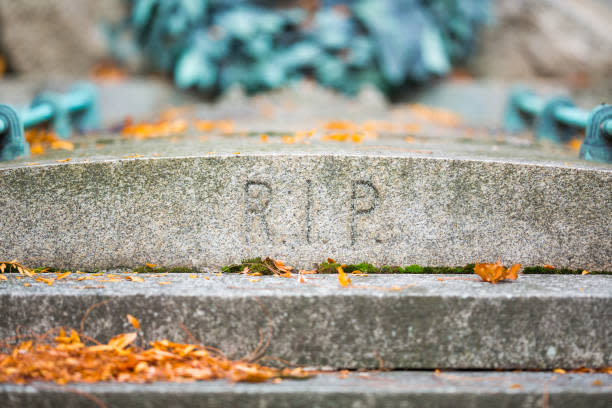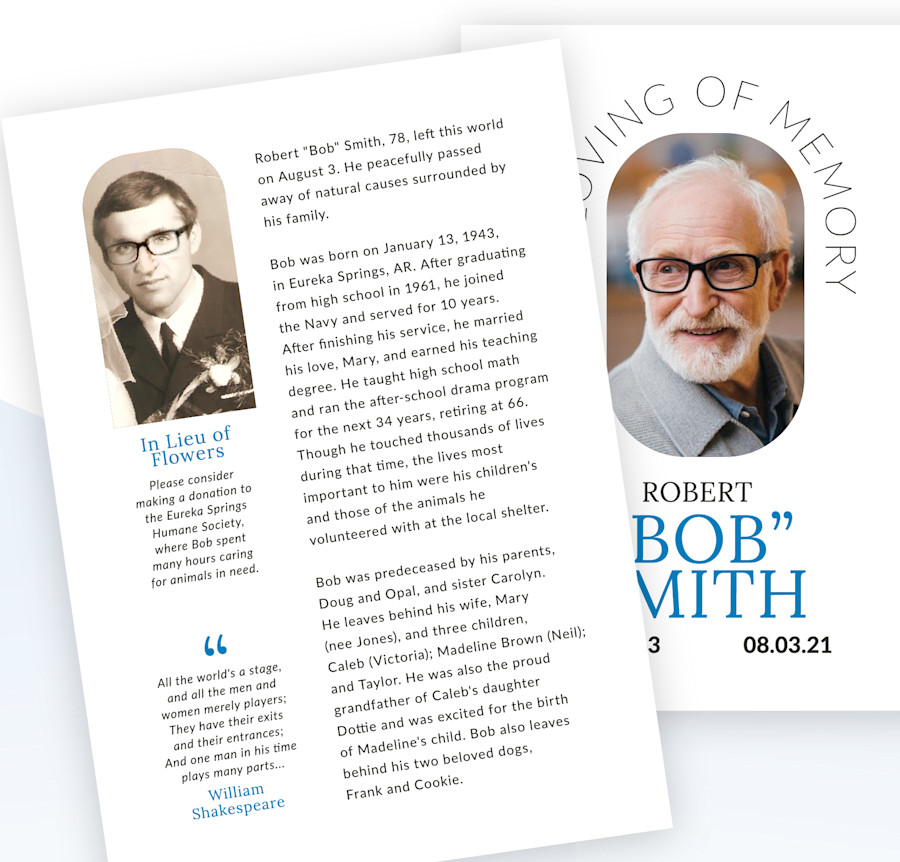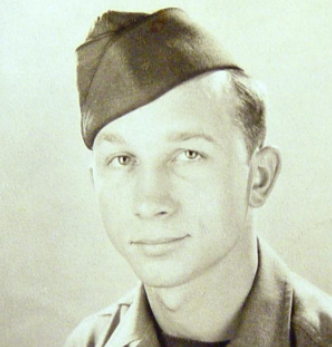
How To
How To Write A Great Obituary | GoodTrust

The time between a death and a funeral is often two to four weeks, particularly if the funeral will include an open casket. Therefore, writing the obituary often needs to happen quickly while the grief is still very fresh.
Thankfully, there's a traditionally accepted formula used for obituaries that may help.
This article explores how to write and submit an obituary, provides some examples of famous (and infamous) obits to inspire you, and provides details about how an online legacy service may be able to help.
Prepare to Write the Obituary
Unless the deceased chose to write their obituary, which happens occasionally, you need to do some legwork before getting started.
Legally, no specific person needs to write the obituary, nor is someone required to write it alone. Unless the deceased specified who they want writing it, this task can be given to a person or group who knew the person well enough to write a fantastic obituary.
Reach Out to Friends and Family
Reaching out to close friends and family can help inform what goes into the obituary.
Ask them to share memorable stories and photos from your loved one’s life. (This is also a good time to start getting people involved in the funeral planning.)
You can ask them to provide or verify information about the decedent’s:
Date and place of birth
Full name and any nicknames
Consider asking if any of the nicknames have any fun stories behind them
Friends, mentors, and family members that should be mentioned in the obituary
Personality traits
Preferred tone for the obituary (e.g. somber or humorous?)
Exact cause of death, if they were an organ donor, or any other end-of-life details you may want to include (optional)
Choose Where to Publish
Before writing up the obituary, figure out where you want to publish, what information you want to be shared in each (e.g., do you want funeral details in one but not another?), and how to meet the individual publications' requirements.
Some common places to publish obituaries are:
Printed newspapers: Local or national depending on your situation; often has a per-character or per-inch cost.
Obituary sites: Often less limited in length; usually less expensive than printed papers, if not free.
Funeral home or church website: Usually built into the cost of the funeral services; restrictions vary by location.
Work-related publications: Could be good if the deceased was well-known in their field; requirements vary.
Community publications: If active in the community, the death may be worth announcing in a local newsletter or similar; requirements vary.
Social media: Can create a unique memorial page with an obituary or post it on the deceased's own memorialized Facebook or a similar account; very few restrictions.
There may be other options based on your loved one's unique circumstances.
How to Write and Submit an Obituary in 8 Steps

When writing an obituary, there is a set of steps people typically follow. Below, we'll detail each step and provide examples of what those steps look like using an imaginary person named "Bob Smith."
For our purposes, "Bob Smith" was a 78-year-old man who was in the Navy, went on to become a teacher, had a wife and three children, and passed away from natural causes. These basics of "Bob" guide the writing, but our examples will give him some personality that can't be shown with just this kind of demographic information.
So, some of these options may seem a bit "out of the box." But, remember: This is all about how that person would want to be memorialized.
Let's dig in.
1. Announce the Death
Obituaries usually begin with an announcement of the person's death. It can include any combination of date, age, cause, location, and names/nicknames of the deceased. A few examples could be:
Robert "Bob" Smith, 78, left this world on August 3. He peacefully passed away of natural causes surrounded by his family.
Robert "Bob" Smith passed away on August 3, 2021, at the age of 78.
Bob (don't you dare call him Robert!) Smith exited this world on August 3 at the age of 78. Though it was of natural causes, he asked us to make up something more interesting. But, we'll never be as creative as he was.
Some people opt to mix this section with the next part.
2. Discuss Milestones and Interests
Next, people usually include significant achievements and milestones of the person they loved. This section is open to interpretation and can include:
Important dates: Birth, graduations, marriage, retirement, business openings, etc.
Academic achievements: Degrees, certifications, and where they were earned
Work achievements: Where they worked, promotions they got, awards won, etc.
Volunteerism and oher community involvement: Charities, non-profits, or local organizations they volunteered at
Hobbies: What were they passionate about? What did they do in their free time?
Military service (if relevant): Any participation in the military, for how long, and any achievements they earned during their service
There is no such thing as a "boring life," and anything you or they would be proud of can go in this section.
For Bob’s obituary, we could write:
Bob was born on January 13, 1943, in Eureka Springs, AR. After graduating from high school in 1961, he joined the Navy and served for 10 years. After finishing his service, he married his love, Mary, and earned his teaching degree. He taught high school math and ran the after-school drama program for the next 34 years, retiring at 66. Though he touched thousands of lives during that time, the lives most important to him were his children's and those of the animals he volunteered with at the local shelter.
Eureka Springs, AR, welcomed Bob into this world on June 13, 1943. He later joined the Navy, married his wife at 28, and became a long-time teacher and drama program director. After retiring, he spent a lot of time volunteering with his local animal shelter.
Bob made his dramatic entrance on June 13, 1943, in Eureka Springs, AR, after putting his mother through 36 hours of labor—something she never let him forget. After finishing high school "solidly in the middle of his class," he joined the Navy and, subsequently, refused to be on a boat for the rest of his life. After leaving the service, he married his long-suffering wife and tormented many math and theatre students for 34 years before freeing them. He spent the rest of his days volunteering with animals and yelling at his television.
3. List Family Members
After going through the interests and milestones of the person, their family is traditionally mentioned. Close friends and pets may also be included, depending on the person.
Family members who have already passed are often mentioned with phrases like "preceded in death" or "the late”. In addition, spouses' former last names are often in parentheses, as are children's spouses' first names.
As mentioned, Bob was married with three children. His obituary could read:
Bob was predeceased by his parents, Doug and Opal, and sister Carolyn. He leaves behind his wife, Mary (nee Jones), and three children, Caleb (Victoria); Madeline Brown (Neil); and Taylor. He was also the proud grandfather of Caleb's daughter Dottie and was excited for the birth of Madeline's child. Bob also leaves behind his two beloved dogs, Frank and Cookie.
Bob's parents, Doug and Opal, and sister Carolyn are waiting for him on the other side. He will be greatly missed by his wife, Mary, and children, Caleb (Victoria), father of Dottie; Madeline Brown (Chris), mother-to-be of a new grandchild; and Taylor. Additionally, he leaves behind his prized Great Danes, Frank, and Cookie.
Bob is now the problem of his parents, Doug and Opal, and his sister Carolyn. He doesn't need the ego boost, so don't tell him he'll be missed by his wife, Mary, and three children: Caleb (Victoria), Madeline Brown (Chris), and Taylor. His granddaughter Dottie and unborn grandchild probably won't believe the stories we tell about him, but we'll do our best. He'll probably be most missed by his dogs, Frank and Cookie, as he was the never one to refuse them a treat.
4. Provide Funeral Information
Including funeral or reception information is optional depending on whether you want this open to the public. However, if you do, be sure to include any details someone may need. This can include:
Type of service (wake, funeral, celebration of life)
Date and time of the service(s)
Location and exact address of the event(s)
Burial location (if relevant)
If no service will be held or the service will not be open to the public, you can state that or leave the information out entirely. If the memorial will be held at a later date, say that. A few ways to phrase things include:
Funeral services will be held at ABC Funeral Home (1234 Main Street) on August 20 at 3:00 pm.
A full church service will be held at ABC Church at 3:00 pm on August 20.
An informal, casual memorial will be held at Caleb's home on August 20 at 3:00 pm.
No service is planned at this time, but the information is to come.
There will be no service.
An intimate service is planned, and it will not be open to the public.
5. Tell People What to Send
People often want to do something, anything, to help out in a time of grief. When writing the obituary, be specific about what people can do to honor your loved one and help out the family.
Frequently, you'll see the phrase "In lieu of flowers…" as flowers are a traditional gift to send to the loved one's family. Instead of flowers, people often ask for:
Donations to a favorite charity.
Funds for medical and funeral costs.
Money for their children or grandchildren's education.
Performing a random act of kindness in the loved one's memory.
6. Select a Photo
Obituaries almost always have at least one photo at the top. The photos can be serious or goofy, professional or unprofessional, current or from years ago.
Be sure they're something that person would want to be included and shows them in a good light. This doesn't mean it has to be a formal photo but one that shows off their personality and makes them look great, even if they're making a silly face.
The photos almost always only have the person alone. However, some may be with a loved one, such as a photo from their wedding day. The latter is especially true if family members died together or in short order.
If you struggle to find a photo that meets all these requirements, see if you can get help from a friend adept in photo editing to make a great photo even better.
A few examples for Bob could be:
A formal, smiling photo showing a gentle side of him

A serious, dramatic photo, showing his more intellectual side

Even a silly photo showing his enjoyment of pizza and beer

You can also choose a photo from your loved one's younger days. This could be something like a photo of them in their military uniform, dressed for a special event, or a casual photo they always loved.

7. Conclusion (Optional)
While many obituaries end on the funeral or donation information, some choose to end with a favorite memory, quote, or summation of the person's life.
Since he was a drama teacher for most of his life, we might end Bob’s obituary with:
All the world's a stage, and all the men and women merely players; They have their exits and their entrances; And one man in his time plays many parts...
--William Shakespeare
8. Submit the Obituary
Each place you plan to submit an obituary to has its own requirements.
Newspapers and online publications will likely have the requirements posted on their website. However, you may need to reach out directly when it comes to community or industry publications.
In most cases, print and online publishers ask for a digital version of the obituary. This could mean emailing them the obituary or mailing them a USB drive with the piece.
Before you submit the obituary, be sure to thoroughly proofread it and ask someone else to do the same. Additionally, ask if you can see the obituary before it’s published to verify everything looks like it should.
Sample Obituaries
If you need inspiration, you can look in your local newspapers or at obituary websites like Legacy.com. However, here are a few obituaries of famous people—or those who became famous because of their viral obituaries—to get you started:
Emily DeBrayda Phillips: A heartfelt and funny viral orbituary from 2015, written by the deceased upon learning of a cancer diagnosis.
Lou Reed: An unusual orbituary written by his wife, created as a letter to neighbors instead of following the usual format.
Jonas Salk: Half news article, half orbituary of the person to first discover a polio vaccine.
Rhea Woltman: One of the Mercury 13, Woltman's obituary generally follows the traditional format, adding her plans for her remains.
Mary A. "Pink" Mullaney: Another viral obituary, this one featuring advice "Pink" gve all of her loved ones.
Eric A. Sauser: Viral obituary written by his wife with a combination of humor and heart.
Memorialize and Protect Your Loved One
Writing an obituary can be an emotional and cathartic experience. But remembering your loved one doesn’t have to stop once the final draft has been published.
With GoodTrust, you can help ensure the safety of your loved one's digital afterlife and create unique ways to memorialize them. Animate a photo of your loved one for use on their memorial page or to share with friends and family online. If there’s still time, have your loved one create future messages to send to those they love on a specified date.
Memories, obituaries, and things passed down in their will aren't the only things a loved one leaves behind when they die. They also leave behind an extensive digital afterlife that needs to be memorialized and protected.
Even at our free level, you can take care of a good deal of you or your loved one's digital assets, estate planning, and last goodbyes.
Try GoodTrust for free today.